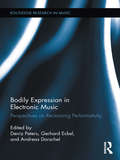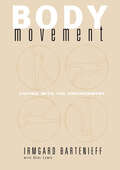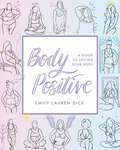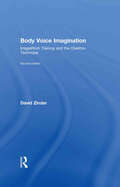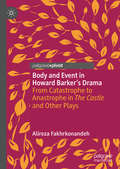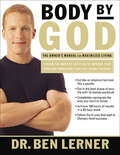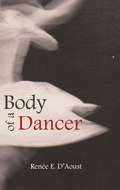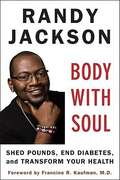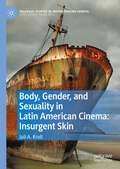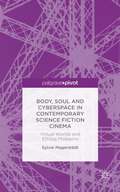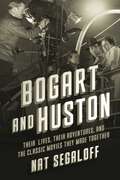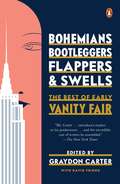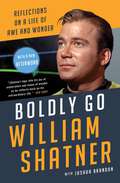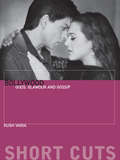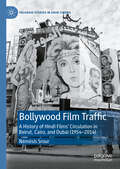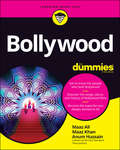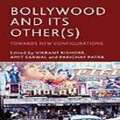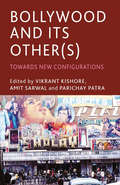- Table View
- List View
Bodily Expression in Electronic Music: Perspectives on Reclaiming Performativity (Routledge Research in Music)
by Deniz Peters Gerhard Eckel Andreas DorschelIn this book, scholars and artists explore the relation between electronic music and bodily expression from perspectives including aesthetics, philosophy of mind, phenomenology, dance and interactive performance arts, sociology, computer music and sonic arts, and music theory, transgressing disciplinary boundaries and established beliefs. The historic decoupling of action and sound generation might be seen to have distorted or even effaced the expressive body, with the retention of performance qualities via recoupling not equally retaining bodily expressivity. When, where, and what is the body expressed in electronic music then? The authors of this book reveal composers’, performers’, improvisers’ and listeners’ bodies, as well as the works’ and technologies’ figurative bodies as a rich source of expressive articulation. Bringing together humanities’ scholarship and musical arts contingent upon new media, the contributors offer inspiring thought and critical reflection for all those seriously engaged with the aesthetics of electronic music, interactive performance, and the body’s role in aesthetic experience and expression. Performativity is not only seen as being reclaimed in live electronic music, interactive arts, and installations; it is also exposed as embodied in the music and the listeners themselves.
Body Genre: Anatomy of the Horror Film (Horror and Monstrosity Studies Series)
by David Scott DiffrientIn this groundbreaking work, author David Scott Diffrient explores largely understudied facets of cinematic horror, from the various odors permeating classic and contemporary films to the wetness, sliminess, and stickiness of these productions, which, he argues, practically scream out for a tactile mode of textural analysis as much as they call for more traditional forms of textual analysis. Dating back to Carol Clover’s and Linda Williams’s pioneering work on horror cinema, film scholars have long conceptualized this once-disreputable category of cultural production as a “body genre.” However, despite the growing recognition that horror serves important biological and social functions in our lives, scholars have only scratched the surface of this genre with regard to its affective, corporeal, and sensorial appeals.Diffrient anatomizes horror films in much the same way that a mad scientist might handle the body, separating and recombining constitutive parts into a new analytical whole. Further, he challenges the tendency of scholars to privilege human over nonhuman beings and calls into question ableist assumptions about the centrality to horror films of sight and sound to the near exclusion of other forms of sense experience. In addition to examining the role that animals—living or dead, real or fake—play in human-centered fictions, this volume asks what it means for audiences to consume motion pictures in which actors, stunt performers, and other creative personnel have put their own bodies and lives at risk for our amusement. Historically grounded and theoretically expansive, Body Genre: Anatomy of the Horror Film moves the study of cinematic horror into previously unchartered waters and breathes life into a subject that, not coincidentally, is intimately connected to breathing as our most cherished dividing line between life and death.
Body Movement: Coping with the Environment
by Irmgard Bartenieff Dori Lewis"'Irmgard Bartenieff has a profound knowledge of the human body and how it moves. I am delighted that this will now be made available to many more people.'." -- George Balanchine of Director, New York City Ballet"'Irmgard Bartenieff's pioneering work in the multiple applications of Labananalysis has had a transforming influence on many areas of movement training. Her careful and detailed development of the spatial principles into active corrective work has illuminated and altered the training of people as varied as dancers, choreographers, physical therapists, movement and dance therapists, and psychotherapists. Anthropologists and non-verbal communication researchers have found their world view necessarily altered by her fundamental innovations. The field of body/mind work will need to adapt to include her clear working through of basic principles.'." -- Kayla Kazahn Zalk of President, American Dance Guild
Body Positive: A Guide to Loving Your Body
by Emily Lauren DickPacked with introspective questions and gorgeous, un-retouched photographs that display the bodies of real, everyday women aimed at teaching young women that every body is beautiful and happiness comes in all shapes and sizes. A Foreword Reviews recommended title for Mental Health Awareness Month
Body Voice Imagination: ImageWork Training and the Chekhov Technique (A\theatre Arts Book Ser.)
by David ZinderFirst published in 2008. Routledge is an imprint of Taylor & Francis, an informa company.
Body and Event in Howard Barker's Drama: From Catastrophe to Anastrophe in The Castle and Other Plays
by Alireza FakhrkonandehThis book explores questions of gender, desire, embodiment, and language in Barker’s oeuvre. With The Castle as a focal point, the scope extends considerably beyond this play to incorporate analysis and exploration of the Theatre of Catastrophe; questions of gender, subjectivity and desire; God/religion; aesthetics of the self; autonomy-heteronomy; ethics; and the relation between political and libidinal economy, at stake in 20 other plays by Barker (including Rome, The Power of the Dog, The Bite of the Night, Judith, Possibilities, I Saw Myself, Fence in Its Thousandth Year, The Gaoler’s Ache for the Nearly Dead, The Brilliance of the Servant, Golgo, among others).
Body by God: The Owner's Manual for Maximized Living
by Ben LernerYour body is by God. God preprogrammed you to look great, have outrageous health, and experience incredible happiness. In the human body, God created a perfect design, equipped with all the organs, tissues, and cells necessary for health, production, and reproduction. The problem, asserts Dr. Ben Lerner, is when we as humans interfere with God's design for our bodies. Junk food, high-stress living, and neglecting exercise are just a few of the things we do to hinder our bodies' performance.In Body by God, Dr. Lerner offers a comprehensive plan for getting in touch with our bodies in four areas: nutrition, exercise, stress management, and time management. His "5-in-5" plan is designed to instill the good habits that will lead to optimum health benefits. Readers will learn how to get in shape with 10-minute workouts, reprogram the way they react to stress, and more. "Owner's Manual Tips" give specific ways to apply the material to real life. Our bodies are "fearfully and wonderfully made." With the help of Body by God, readers will learn how to achieve the highest level of performance from God's handiwork.
Body of a Dancer
by Renee D'Aoust"A remarkably clear-eyed descent into New York's surreal world of modern dance peopled by the obsessed, dispossessed, sexy, suicidal, brutal, broke, and absurd."-Lance Olsen, author of Nietzsche's KissesThe award-winning writer Renée E. D'Aoust draws from her experiences as a modern dancer in New York during the nineties. Her luminous prose spotlights this passionate, often brutal world. Trained at the prestigious Martha Graham Center, D'Aoust intertwines accounts of her own and other dancers' lives with essays on modern dance history. A dancer's body, scarred, strained, and tough, bears witness to the discipline demanded by the art form. Body of a Dancer provides a powerful, acidly comic record of what it is to love, and eventually leave, a life centered on dance."With exquisite description, absolute honesty, and a clear compelling voice, Body of a Dancer offers an unforgettable account of one artist's bittersweet journey."-Dinty W. MooreRenée E. D'Aoust's essays have been featured as notable essays in Best American Essays in 2006, 2007, and 2009. Her nonfiction work has been included in the anthology Reading Dance, edited by Robert Gottlieb and nominated for the Pushcart Prize. D'Aoust is the recipient of an NEA Dance Criticism fellowship and grants from The Puffin Foundation and the Idaho Commission on the Arts.
Body with Soul
by Randy JacksonFrom beloved American Idol judge a complete, inspiring wellness plan for taking control of your health The obesity epidemic is spreading throughout America, bringing with it health problems from diabetes to hypertension to heart disease. A lifetime of poor fitness and nutrition choices left Randy Jackson lethargic, overweight, and with a diagnosis of Type II diabetes. After years of yo-yo diets, hours in the gym, and even gastric bypass surgery, Randy finally decided to change his life. Body with Soul is his tried-and-true wellness plan; filled with meal plans, re-tooled recipes of Southern favorites, and workouts for people on the go, the regimen here is user-friendly and promises results. Having lost one hundred pounds, Randy is healthier than ever, and his diabetes has been in remission for five years. The program offered by Body with Soul ensures that readers, like Randy, can get their health in check, and lead happier, healthier lives. .
Body, Gender, and Sexuality in Latin American Cinema: Insurgent Skin (Palgrave Studies in (Re)Presenting Gender)
by Juli A. KrollInsurgent Skin: Body, Gender, and Sexuality in Latin American Cinema argues that twenty-first century Latin American cinema about lesbian, feminist, intersex, and transgender themes is revolutionary because it disrupts heteronormative and binary representation and explores new, queer signifying modes.Grounded in feminist and queer theory, Insurgent Skin conjugates film phenomenology and theories of affect and embodiment to analyze a spectrum of Latin American films.The first chapters explore queer signifying in Argentinean director Lucrecia Martel’s Salta trilogy and the lesbian utopia of Albertina Carri’s Las hijas del fuego (2018). Next, the book discusses the female body as uncanny absence in Tatiana Huezo’s documentary Tempestad (2016), a film about gendered violence in Mexico. Chapter Five focuses on intersex films and the establishing of queer solidarity and an intersex gaze. The last chapter examines transgender embodiment in the Chilean film Una mujer fantástica (2017) and Brazilian documentary Bixa Travesty (2018).
Body, Soul and Cyberspace in Contemporary Science Fiction Cinema: Virtual Worlds and Ethical Problems
by Sylvie MagerstädtBody, Soul and Cyberspace explores how recent science-fiction cinema addresses questions about the connections between body and soul, virtuality, and the ways in which we engage with spirituality in the digital age. <P><P> The book investigates notions of love, life and death, taking an interdisciplinary approach by combining cinematic themes with religious, philosophical and ethical ideas. Magerstadt argues how even the most spectacle-driven mainstream films such as Avatar, The Matrix and Terminator can raise interesting and important questions about the human self and our interaction with the world. <P><P>Apart from these well-known science fiction epics, her analysis also draws on recent works, such as Inception, The Thirteenth Floor, eXistenZ, Aeon Flux, Total Recall (2012), Transcendence and TRON: Legacy. These films stimulate an engaging discussion on what makes us human, the role memory plays in understanding ourselves, and how virtual realities challenge the moral concepts that govern human relationships.
Bogart and Huston: Their Lives, Their Adventures, and the Iconic Movies They Made Together
by Nat SegaloffFrom 1941 to 1953, director John Huston and actor Humphrey Bogart made one classic film after another, from The Maltese Falcon to The African Queen. Here is the story of their close but combative friendship that produced some of the best movies ever made. Every time they made a movie together, they made a classic—or so it seemed for star Humphrey Bogart and writer/director John Huston. Their six collaborations from 1941 and 1953 include many of the "golden age&” hits from Hollywood&’s fabled film legacy: The Maltese Falcon, Across the Pacific, The Treasure of the Sierra Madre, Key Largo, The African Queen, and Beat the Devil. At the same time, both men led fiercely separate lives—except when they were making pictures together. Sometimes they agreed and sometimes they argued, always keeping their eyes on the results. What did each man bring to the collaboration, and how did their six films together reflect their disparate personalities? Their friendship was as dramatic as any of their movies. It survived nine marriages, a world war, the blacklist, leeches, alcohol, and Jack L. Warner. Here is the story of these two legendary talents, their films, their lives, their foes, and their remarkable devotion to each other
Bogie & Bacall: The Surprising True Story of Hollywood's Greatest Love Affair
by William J. MannFrom the noted Hollywood biographer and author of The Contender comes this celebration of the great American love story—the romance between Lauren Bacall and Humphrey Bogart—capturing its complexity, contradictions, and challenges as never before.In Bogie & Bacall, William Mann offers a deep and comprehensive look at Lauren Bacall, Humphrey Bogart, and the unlikely love they shared. Mann details their early years—Bogart’s effete upbringing in New York City; Bacall’s rise as a model and actress. He paints a vivid portrait of their courtship and twelve-year marriage: the fights, the reconciliations, the children, the affairs, Bogie’s illness and Bacall’s steadfastness until his death. He offers a sympathetic yet clear-eyed portrait of Bacall’s life after Bogie, exploring her relationships with Frank Sinatra and Jason Robards, who would become her second husband, and the identity crisis she faced.Surpassing previous biographies, Mann digs deep into the celebrities’ personal lives and considers their relationship from surprising angles. Bacall was just nineteen when she started dating the thrice-married forty-five-year-old Bogart. How might that age gap have influenced their relationship? In addition to what she gained, what might Bacall have lost by marrying a Hollywood superstar more than twice her age? How did Bogart, a man of average looks, become one of the greatest movie stars of all time? Throughout, Mann explains the unparalleled successes of their individual careers as well as the extraordinary love between them and the legend that has endured.Filled with entertaining details and thoughtful insights based on newly available records and correspondence, and illustrated with 30-40 photographs, Bogie & Bacall offers a fresh look at this famous couple, their remarkable relationship, and their legacy.
Bohemians, Bootleggers, Flappers, and Swellss: The Best of Early Vanity Fair
by Graydon Carter David FriendOffering readers an inebriating swig from the great cocktail shaker of the Roaring Twenties--the Jazz Age, the age of Gatsby--Bohemians, Bootleggers, Flappers, and Swells showcases unforgettable writers in search of how to live well in a changing era. Vanity Fair editor Graydon Carter introduces these fabulous pieces written between 1913 and 1936, when the magazine published a Murderers' Row of the world's leading literary lights, including:F. Scott Fitzgerald on what a magazine should beClarence Darrow on equalitye. e. cummings on Calvin CoolidgeD. H. Lawrence on womenDjuna Barnes on James JoyceJohn Maynard Keynes on the collapse in money valueDorothy Parker on a host of topics, from why she hates actresses to why she hasn't marriedpo Marx, Carl Sandburg on Charlie Chaplin, Djuna Barnes on James Joyce, Douglas Fairbanks, Jr., on Joan Crawford, and Dorothy Parker on a host of topics ranging from why she hates actresses to why she hasn't married. These essays reflect the rich period of their creation while simultaneously addressing topics that would be recognizable in the magazine today, such as how women should navigate work and home life; our destructive fascination with the entertainment industry and with professional sports; the collapse of public faith in the financial industry; and, as Aldous Huxley asks herein, "What, Exactly, Is Modern?" Offering readers an inebriating swig from that great cocktail shaker of the Roaring Twenties, the Jazz Age, the age of Gatsby, Bohemians, Bootleggers, Flappers, and Swells showcases unforgettable writers in search of how to live well in a changing era.
Boldly Go: Reflections on a Life of Awe and Wonder
by William ShatnerThe beloved star of Star Trek, recent space traveler, and living legend William Shatner reflects on the interconnectivity of all things, our fragile bond with nature, and the joy that comes from exploration with &“the insights he&’s gleaned over his long, productive life&” (Booklist) in this inspiring, revelatory, and exhilarating collection of essays.Long before Gene Roddenberry put him on a starship to explore the galaxy, long before he actually did venture to space, William Shatner was gripped by his own quest for knowledge and meaning. Though his eventful life has been nothing short of extraordinary, Shatner is still never so thrilled as when he experiences something that inspires him to simply say, &“Wow.&” Within these affecting, entertaining, and informative essays, he demonstrates that astonishing possibilities and true wonder are all around us. By revealing stories of his life—some delightful, others tragic—Shatner reflects on what he has learned along the way to his ninth decade and how important it is to apply the joy of exploration to our own lives. &“A refreshingly self-aware portrait of a man determined to live every moment to the fullest&” (Publishers Weekly), Boldly Go is an unputdownable celebration of all that our miraculous universe holds for us.
Bollywood
by Kush VariaWhile we have become familiar with the idea of "Bollywood" here in the West, we know little about the industry's films beyond a certain celebration of kitsch. Bollywood, the latest in Wallflower Press's Short Cuts introductory series, surveys this style of filmmaking from its origins in colonial times to the present, tracing its impact on both the Indian and global imagination. Chapters explore the history and workings of the industry, the narratives and aesthetics of its films, varieties within the genre, the cultural connotations of specific characters, its larger-than-life stars, and its hybrid and surprising fan cultures. Readings of popular and widely available films illustrate the importance of the cinema's conventions, which range from romantic clichés to a constant negotiation between tradition and modernity.
Bollywood Burglary (Geronimo Stilton #65)
by Geronimo StiltonWhen you're with Geronimo Stilton, it's always a fabumouse adventure!My detective friend Hercule Poirat and I were headed to India. A Bollywood star we're friends with had received a valuable ruby and wanted us to help her protect it... which meant that I ended up acting in the movie she was filming! Rancid ricotta -- I'm a terrible actor! Even worse, just when we least expected it, the ruby was stolen. Could we find the thief?
Bollywood Film Traffic: A History of Hindi Films’ Circulation in Beirut, Cairo, and Dubai (1954–2014) (Palgrave Studies in Arab Cinema)
by Némésis SrourThis book brings to light a lesser-explored facet of cultural globalization by unearthing Bollywood films circulations in the Middle East. Delving into the intricacies of South-South cinematic circuits, it unveils the networks linking the Bombay film industry with the Arab world. Through a blend of historical analysis and ethnographic insights, the book offers an exploration of how film circulations have evolved amidst geopolitical shifts and technological advancements. By reframing our perspective to view Arab cinema cultures through the lens of the Bombay film industry, it challenges prevailing Orientalist narratives, offering a nuanced and refreshing portrayal of the Arab-speaking region.
Bollywood For Dummies
by Anum Hussain Maaz Ali Maaz KhanTake the trip of a lifetime into the past and present of Bollywood Fascinated by the high energy, high emotion, high color, endless dance routines, and sheer scale of Bollywood—but afraid you'll never really know your Ghazals from your Qawwalis, or your Khans from your Kapoors? Well, in the immortal line from the Hindi-language blockbuster Sultan, "No one can defeat you unless you accept defeat yourself," and there's no need to be defeated at all when you can sit back with Bollywood For Dummies and immerse yourself in the glamorous whirl of one of the most exciting movie industries on Earth. Starting with the time-travel adventure of the book’s main feature—the history of the Hindi-speaking industry from people and events of early to mid 20th century Mumbai—you'll also journey in space, taking fascinating documentary side trips to get to know Tollywood’s Telegu-language cinema in southern India, as well as the growing influence of Lollywood across the border in Pakistan. Written by the cohosts of Desi Standard Time, a podcast that explores Bollywood and South Asian movies and media, you'll see how the unique cinema culture of Bollywood in particular has become a global phenomenon, reflecting the rise of India as an independent nation and presenting its long history—and it’s exciting and multifaceted present—in new, influential, and enduring forms. Whatever you paid the price of entry for: the popular Bollywood "Masala" movie style that emphasizes music, comedy, romance, and action; sensitive critiques of a fast-changing society by the Indian Social Realism movement; new forms of music from Indian disco to Sufi boogie; or a look at the lives and talents of the great acting dynasties—it's all here. And there'll still be plenty more plot twists beyond these to surprise and delight you. Get to know the people who built Bollywood Discover the main music and dance styles Explore and recognize Bollywood’s influence on Western cinema Go social and join up with the liveliest Bollywood fan communities You're right to be excited: for newbies a whole new world awaits, and for aficionados, there's always so much more to know. So, sit back with this book, grab some popcorn or a plate of samosas—or why not both—and prepare to begin an electric feast to sizzle all your senses.
Bollywood and Its Other(s)
by Vikrant Kishore Amit Sarwal Parichay PatraHow do we define the globalized cinema and media cultures of Bollywood in an age when it has become part of the cultural diplomacy of an emerging superpower? Is it still an 'other' industry in a world dominated by Hollywood? Bollywood and Its Other(s) aims to compensate for the lack of scholarly literature on Indian film by opening up hitherto unexplored sites or sites that are in formation. It focuses on the aesthetic-philosophical questions of the other, Indian diaspora's negotiations with national identity, alternative reading strategies/research methods, marginal genres (sci-fi, horror), marginal characters (flaneuse, vamps), marginal gender (non-normative sexualities), marginal cinema (Hindi avant-garde), marginal language (Hinglish), and marginal regions (the Kashmir valley). It intends to address film scholars, South Asian studies researchers, cinephiles and lay readers alike.
Bollywood and its Other(s): Towards New Configurations
by V. Kishore A. Sarwal P. PatraHow do we define the globalized cinema and media cultures of Bollywood in an age when it has become part of the cultural diplomacy of an emerging superpower? Bollywood and Its Other(s) explores the aesthetic-philosophical questions of the other through, for example, discussions on Indian diaspora's negotiations with national identity.
Bollywood's India
by Priya JoshiIn a work of dazzling interpretive virtuosity, Priya Joshi returns popular Hindi cinema to the 1970s when the term "Bollywood" was deployed to dismiss an unruly cultural product marked by its social responsiveness. Joshi analyzes the social work of popular Hindi blockbusters that, she argues, capture and challenge the diffuse aspirations of the nation. The "India" fabricated in Bollywood's blockbusters revises and contests nation and the state, commenting on an India both imagined and real. Familiar depictions of crime and punishment, family and individuality, vigilante and community, have persisted in the cinema across half a century despite dramatic changes in the industry's production and distribution practices. Summoning the 1970s as an interpretive lens, Joshi deftly examines blockbusters from notably tumultuous moments when the idea of India was made, unmade, and remade. From the decline of the studios in the 1950s to the rise of the multi-starrer genre in the 1970s and the arrival of corporate capital and new media platforms in the 2000s, Bollywood's blockbusters nimbly engage the public fantasies of their heterogeneous audiences. Joshi's elegantly crafted argument incorporates fresh explorations of iconic films such as Awara (1951) and Deewaar (1975), as well as those less analyzed, such as Ab Dilli Dur Nahin (1957) and A Wednesday (2008).
Bollywood's India: A Public Fantasy
by Priya JoshiBollywood is India's most popular entertainment and one of its most powerful social forces. Its blockbusters contest ideas about state formation, capture the nation's dispersed anxieties, and fabricate public fantasies of what constitutes "India." Written by an award-winning scholar of popular culture and postcolonial modernity, Bollywood's India analyzes the role of the cinema's most popular blockbusters in making, unmaking, and remaking modern India. With dazzling interpretive virtuosity, Priya Joshi provides an interdisciplinary account of popular cinema as a space that filters politics and modernity for its viewers. Themes such as crime and punishment, family and individuality, vigilante and community capture the diffuse aspirations of an evolving nation. Summoning India's tumultuous 1970s as an interpretive lens, Joshi reveals the cinema's social work across decades that saw the decline of studios, the rise of the multi-starrer genre, and the arrival of corporate capital and new media platforms. In elegantly crafted studies of iconic and less familiar films, including Awara (1951), Ab Dilli Dur Nahin (1957), Deewaar (1975), Sholay (1975), Dil Se (1998), A Wednesday (2008), and 3 Idiots (2009), Joshi powerfully conveys the pleasures and politics of Bollywood blockbusters.
Bollywood: A Guidebook to Popular Hindi Cinema (Routledge Film Guidebooks)
by Tejaswini Ganti'Bollywood' is the dominant global term to refer to the prolific Hindi language film industry in Bombay (renamed Mumbai in 1995). Characterised by music, dance routines, melodrama, lavish production values and an emphasis on stars and spectacle, Bollywood films have met with box-office success and enthusiastic audiences from India to West Africa to Russia, and throughout the English-speaking world. In Bollywood, anthropologist and film scholar Tejaswini Ganti provides a guide to the cultural, social and political significance of Hindi cinema, outlining the history and structure of the Bombay film industry, and the development of popular Hindi filmmaking since the 1930s. Providing information and commentary on the key players in Bollywood, including directors and stars, as well as material from current filmmakers themselves, the areas covered in Bollywood include: history of Indian cinema narrative style, main themes, and key genres of Hindi cinema significant films, directors and stars production and distribution of Bollywood films interviews with actors, directors and screenwriters.
Bollywood: Gods, Glamour, and Gossip (Short Cuts)
by Kush VariaWhile we have become familiar with the idea of "Bollywood" here in the West, we know little about the industry's films beyond a certain celebration of kitsch. Bollywood, the latest in Wallflower Press's Short Cuts introductory series, surveys this style of filmmaking from its origins in colonial times to the present, tracing its impact on both the Indian and global imagination. Chapters explore the history and workings of the industry, the narratives and aesthetics of its films, varieties within the genre, the cultural connotations of specific characters, its larger-than-life stars, and its hybrid and surprising fan cultures. Readings of popular and widely available films illustrate the importance of the cinema's conventions, which range from romantic clichés to a constant negotiation between tradition and modernity.
